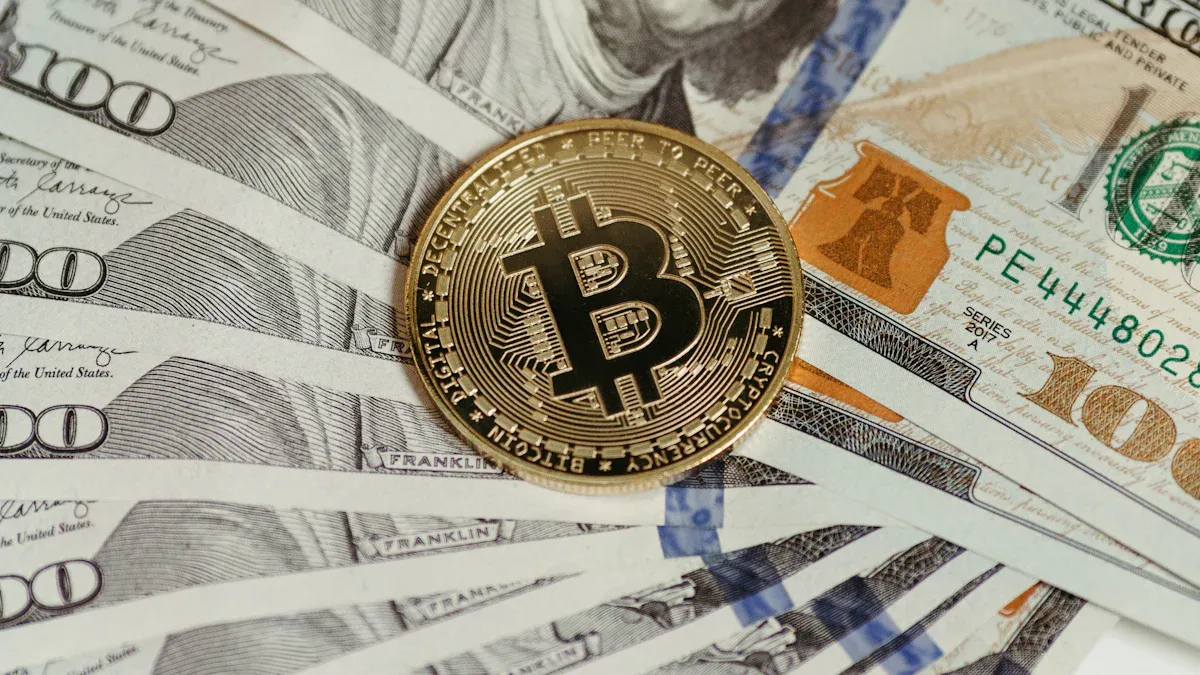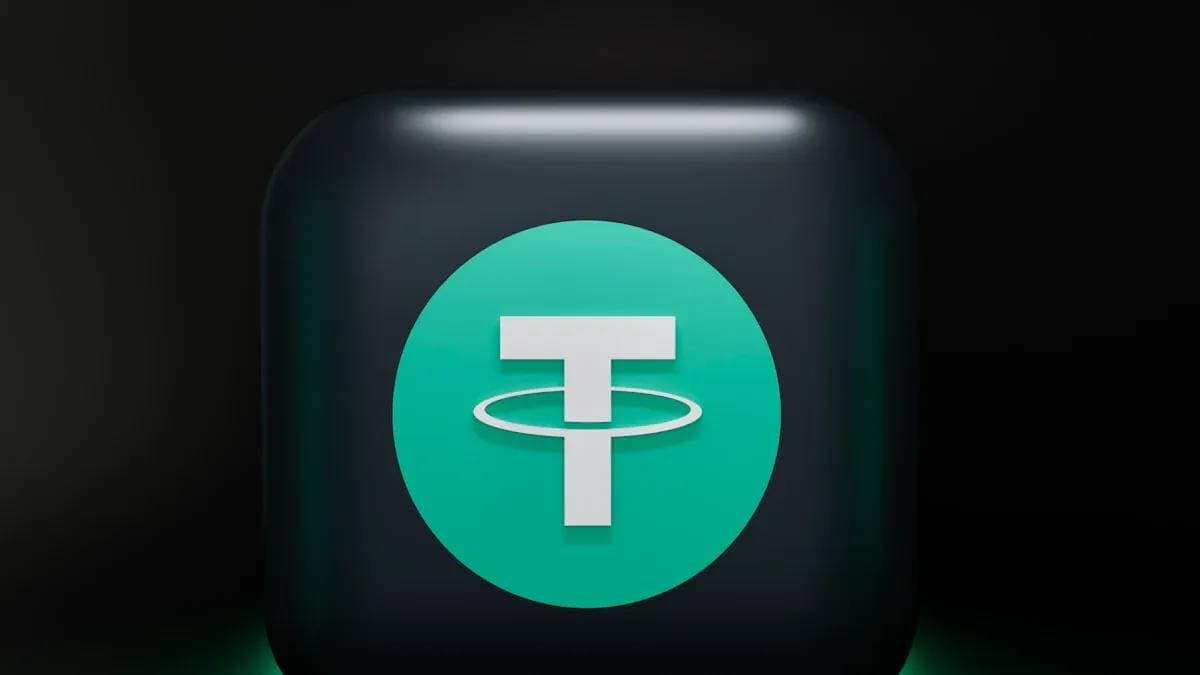- EasyCard
- Trade
- Help
- Announcement
- Academy
- SWIFT Code
- Iban Number
- Referral
- Customer Service
- Blog
- Creator
How Enterprises Can Use Cryptocurrency for International Remittance: Compliance Framework and Practical Guide

Image Source: pexels
Your enterprise can fully utilize cryptocurrency to handle international remittance, but the key prerequisite for success is establishing a rigorous global compliance framework. Facing the continuously growing global remittance demand, finding an efficient and compliant payment solution is crucial.
Global Remittance Market Continues to Expand
- In 2023, the total global remittance amount reached a record $818 billion.
- In the same year, inflows to low- and middle-income countries grew to $656 billion.
This cryptocurrency remittance guide aims to provide a clear practical blueprint to help your enterprise enjoy efficiency advantages while ensuring operations are completely legal and secure.
Key Points
- Enterprises can use cryptocurrency for international remittance, but must comply with global legal regulations.
- Cryptocurrency remittance is faster, lower-cost, and has more transparent transaction records than traditional banks.
- Enterprises need to establish strict compliance systems, including knowing customer identity, anti-money laundering, and sanctions list screening.
- Choosing USD-pegged stablecoins for remittance can avoid risks from cryptocurrency price fluctuations.
- Enterprises should select licensed cryptocurrency service providers and carefully verify recipient addresses and networks to ensure fund security.
Why Choose Cryptocurrency for International Remittance

Image Source: unsplash
When your enterprise faces high bank handling fees and long waiting times, cryptocurrency provides a modern solution. It can not only optimize your cash flow but also significantly improve operational efficiency.
Comparison with Traditional Wire Transfers: Advantages in Cost, Speed, and Transparency
Traditional wire transfers rely on complex correspondent bank networks (such as the SWIFT system), leading to slow processes and high costs. Cryptocurrency remittance bypasses these intermediate links through blockchain technology.
You can refer to the table below for an intuitive understanding of the differences:
| Feature | Traditional Wire Transfer (SWIFT) | Cryptocurrency Remittance |
|---|---|---|
| Transaction Cost | Higher, involving multiple bank fees | Extremely low, only need to pay network gas fees |
| Arrival Speed | 2-5 business days | Usually completed within minutes |
| Transparency | Limited, difficult to track funds | Completely transparent, transactions publicly queryable |
How Does Blockchain Improve Transparency? Blockchain technology provides a public distributed ledger. This means:
- Unlike the SWIFT system, you no longer need to blindly trust banks. You can verify and track payment status on the blockchain at any time.
- All transaction records are encrypted and permanently stored, which not only reduces fraud risks but also provides clear tracking paths for compliance audits.
Typical Business Scenarios: Supplier Payments and Cross-Border Salaries
This cryptocurrency remittance guide will show you two typical scenarios to help you understand its application value in actual business.
- Paying Global Suppliers Suppose you need to pay a $5,000 service fee to a software supplier in Vietnam. Through traditional banks, this remittance may take three days and incur comprehensive fees of about $50-$100. If using a stablecoin (such as USDC) for payment, the transaction can be completed in 10 minutes, with costs usually less than $1.
- Issuing Cross-Border Employee Salaries If your enterprise has an international remote team, paying salaries to employees in different countries is a challenge. Using cryptocurrency, you can bypass complex banking systems in various countries, achieving instant, low-cost unified salary distribution, ensuring every employee receives payment on time.
Building a Global Remittance Compliance Framework
Using cryptocurrency for international remittance, the core is not technical operations but compliance first. A sound compliance framework is the cornerstone for your enterprise to safely and legally enjoy the advantages of cryptocurrency payments. It not only protects your enterprise from legal risks but also enhances partners’ trust in you.
Identify Legal Requirements in Key Jurisdictions
Your first step is to identify and understand the laws and regulations in all relevant jurisdictions. This includes not only the region where your enterprise is located but also the countries or regions where your recipients (such as suppliers or employees) are located. Regulatory policies vary greatly across regions, and you must ensure every transaction complies with the legal requirements of both the remitting and receiving parties.
Compliance Solution: "Licensed Agent Model"
Facing complex global regulations, you can partner with “licensed agents” who hold legal licenses in target markets. These local service providers handle the final exchange and settlement of fiat currency, ensuring fund inflows and outflows fully comply with local regulations. This model can effectively reduce the complexity and cost of directly applying for multi-country licenses.
Establish Anti-Money Laundering (AML) and Counter-Terrorism Financing (CFT) Standards
Anti-Money Laundering (AML) and Counter-Tinancing of Terrorism (CFT) are the core of global financial compliance. Your enterprise must establish strict internal standards to prevent your payment channels from being used for illegal activities.
Simply put:
- AML (Anti-Money Laundering): Aims to prevent criminals from disguising illegally obtained “dirty money” as legitimate funds through transactions.
- CFT (Counter-Financing of Terrorism): Aims to cut off funding channels for terrorist organizations.
To establish an effective AML/CFT system, you can follow these industry best practices:
- Conduct Comprehensive Risk Assessments: You need to regularly assess potential money laundering risks in your business and adjust compliance strategies based on assessment results.
- Understand Crime Types: Your team needs to understand common money laundering methods in the crypto field, such as on-chain mixing, using privacy coins for transactions, or dispersing funds through multiple addresses.
- Build a Professional Compliance Team: Ensure your compliance team has expertise in identifying suspicious transactions and understands the evolving crypto risk landscape.
- Integrate Automated Compliance Technology: Using professional compliance software, you can automate transaction monitoring and customer background checks, improving efficiency and accuracy.
- Clarify Internal Responsibilities and Training: You need to appoint a dedicated Money Laundering Reporting Officer (MLRO) and ensure all relevant employees understand their roles and responsibilities in the compliance process, receiving regular training.
Implement Customer (KYC) and Business (KYB) Identity Verification
KYC (Know Your Customer) and KYB (Know Your Business) are the specific execution links of AML policies. Before transacting with any individual or entity, you must verify their true identity.
- KYC (Know Your Customer): For individual recipients (such as remote employees). You need to collect and verify their basic identity information, usually including:
- Legal Name
- Date of Birth
- Residential Address
- Government-Issued ID (such as passport)
- Biometric Verification (such as “selfie + liveness detection”) to ensure it is the person operating
- KYB (Know Your Business): For enterprise recipients (such as suppliers). You need to conduct more in-depth due diligence to verify the legitimacy of the counterparty enterprise. Required documents usually include:
- Company Registration Certificate
- Shareholder Register and Ownership Structure Chart
- Identity Proof of Directors and Authorized Signatories
- Business License or Permit
Note: Enhanced Due Diligence (EDD)
If your transaction counterparty is from a high-risk region or is a “Politically Exposed Person” (PEP), you need to initiate Enhanced Due Diligence (EDD) for deeper background and fund source reviews.
Integrate International Sanctions List Screening Process
To avoid transactions with sanctioned individuals, entities, or countries, your compliance process must include real-time screening of international sanctions lists. This includes lists published by the United Nations, the U.S. Office of Foreign Assets Control (OFAC), the European Union, etc.
Manual screening is inefficient and error-prone. We recommend integrating professional automated screening tools. These tools can seamlessly access your payment process via API, automatically completing screening before each transaction.
Here are some platforms providing sanctions list screening services:
| Platform | Main Features | API Integration |
|---|---|---|
| ComplyAdvantage | Real-time sanctions lists, PEP, adverse media screening | Yes |
| Sanction Scanner | Extensive sanctions list coverage, supports batch screening | Yes |
| LexisNexis | Comprehensive risk screening and case management | Yes |
| Chainalysis | Focuses on blockchain analysis and crypto address screening | Yes |
Choosing a platform that supports cryptocurrency transaction monitoring can help you automatically identify risks related to blacklisted wallet addresses.
Obtain Necessary Licenses such as Money Services Business (MSB) and Money Transmitter License (MTL)
If you plan to directly handle cryptocurrency and fiat currency exchange and transmission business, rather than fully relying on third-party service providers, obtaining corresponding licenses is crucial. In the United States, this mainly involves two levels:
- Federal Level: Money Services Business (MSB) Registration
- Any company engaged in money transmission business in the U.S. must register as an MSB with the Financial Crimes Enforcement Network (FinCEN) of the U.S. Department of the Treasury.
- Registration must be completed within 180 days of business establishment and renewed every two years.
- State Level: Money Transmitter License (MTL)
- In addition to federal registration, you almost need to obtain a state Money Transmitter License (MTL) in every state where you operate.
- Requirements vary by state, usually including submitting business plans, financial statements, executive background checks, and meeting minimum net worth and surety bond requirements.
Obtaining licenses is a complex and costly process. Therefore, many enterprises initially choose to partner with already licensed cryptocurrency service providers as the first step into the market. This cryptocurrency remittance guide recommends prioritizing the partnership model in the early stages of your business.
Focus on Tax Compliance: Reporting Requirements and Potential Tax Implications
Tax compliance is an indispensable part of the entire compliance framework. Using cryptocurrency for payments may trigger tax events, and you must clearly record and report them.
- Potential Tax Implications: In many countries, exchanging cryptocurrency (such as Bitcoin) for fiat currency or using it to pay for services may be considered asset disposal, generating capital gains tax. Using stablecoins can largely avoid tax complexities from price fluctuations.
- Reporting Requirements: You need to keep detailed records of all cryptocurrency transactions, including transaction date, amount, market value at the time of transaction (in USD), and counterparty information, for tax reporting and audits.
Since tax policies vary significantly across countries and change constantly, it is strongly recommended to consult professional tax advisors to ensure your operations fully comply with local tax regulations.
Cryptocurrency Remittance Guide: Step-by-Step Practical Process

Image Source: unsplash
After fully understanding the importance of the compliance framework, the next step is to put theory into practice. A clear, standardized operational process is key to ensuring every remittance is efficient, secure, and compliant. This cryptocurrency remittance guide will break down the entire process for you, helping you get started easily.
Step 1: Select Licensed and Compliant Cryptocurrency Service Providers
Choosing the right partner is your first step to success. An excellent service provider not only offers technical support but also serves as an extension of your compliance system. You need to evaluate potential service providers from multiple dimensions.
How to Evaluate Cryptocurrency Service Providers?
When selecting, you can focus on the following aspects:
- Licensing and Compliance Status: Verify whether the service provider holds legal licenses in major financial centers (such as Singapore MAS, Hong Kong SFC, U.S. FinCEN). For example, platforms like Biyapay clearly display their compliance qualifications.
- Total Cost Structure: Compare comprehensive fees across platforms, including transaction fees, network fees (Gas Fee), and exchange rate spreads for fiat conversion.
- Supported Assets and Networks: Ensure the service provider supports the stablecoins you need (such as USDC, USDT) and multiple blockchain networks (such as ERC20, TRC20) to increase flexibility.
- Fiat In/Out Channels: Examine whether their fiat deposit/withdrawal options are convenient, such as supporting deposits via bank transfer from a licensed Hong Kong bank.
- Technology and API Support: For enterprises with system integration needs, choose service providers offering stable API interfaces, detailed development documentation (SDK), and technical support.
For enterprises handling large transactions, you also need to understand the characteristics of different trading channels. Mainstream choices include centralized exchanges and OTC (Over-the-Counter) platforms.
| Feature | OTC Platform (Over-the-Counter) | Cryptocurrency Exchange |
|---|---|---|
| Transaction Scale | Suitable for large transactions (usually six figures USD and above) | Suitable for small, high-frequency regular transactions |
| Price Impact | Price locked in advance, avoiding market impact | Large orders may cause price slippage |
| Privacy | Transactions conducted privately, not displayed publicly on order books | Transaction records publicly transparent |
| Settlement Terms | Customizable settlement terms negotiable | Fixed settlement terms, non-customizable |
| Liquidity | Smooth execution of large transactions via deep liquidity pools | Good liquidity for mainstream coins, but large transactions may still be limited |
For enterprises needing to pay the equivalent of over $100,000 USD in cryptocurrency, OTC platforms are usually a more stable choice, providing better pricing and privacy protection.
Step 2: Establish Internal Compliance Processes and Risk Control Systems
Even if you choose a compliant service provider, establishing a sound internal risk control system is equally crucial. This system is your enterprise’s “firewall” against operational risks, financial risks, and compliance risks. You can reference mature internal control frameworks like COSO and adjust according to cryptocurrency characteristics.
You need to establish a clear internal control checklist, specifying the responsible person and operational standards for each link:
- Separation of Duties: Ensure that initiating, approving, and recording transactions are handled by different employees or departments. For example, finance personnel initiate payment requests, department heads approve, and the accounting team records and reconciles.
- Access Control: Implement strict permission management for enterprise wallets, private keys, and trading platforms. High-value transactions should enable multi-signature (Multi-sig) authorization, requiring joint approval from multiple managers to execute.
- Transaction Verification: Establish a secondary verification process before executing any transfer. You need to repeatedly confirm the recipient’s wallet address, amount, and business purpose to prevent fund losses due to operational errors.
- Regular Audits and Reconciliations: Establish an internal audit plan to regularly reconcile your ledger records with transaction hashes on the blockchain, ensuring all records are accurate.
Special Nature of Crypto Risk Control
Unlike traditional finance, cryptocurrency transactions operate 24/7 with near-instant settlement. This means your risk decision time is reduced from days to minutes, so you must rely on automated real-time monitoring tools to support your risk control system.
Step 3: Choose Stablecoins as Remittance Medium to Avoid Volatility
Mainstream cryptocurrencies like Bitcoin (BTC) have drastic price fluctuations, and using them directly for remittance brings huge exchange rate risks to enterprises. Therefore, choosing stablecoins pegged 1:1 to fiat currencies (such as USD) is the best practice for enterprise remittance.
Currently, the most liquid and widely used stablecoins on the market are USDT and USDC. Their large market caps and trading volumes ensure you can perform large exchanges at any time.
| Year (as of June 30) | USDT Market Cap (Billion USD) | USDC Market Cap (Billion USD) | Total Market Cap (Billion USD) |
|---|---|---|---|
| 2021 | 78.02 | 42.39 | 120.41 |
| 2022 | 66.24 | 44.35 | 110.59 |
| 2023 | 91.67 | 24.52 | 116.19 |
| 2024 | 138.70 | 43.62 | 182.32 |
| 2025 | 157.62 | 61.68 | 219.30 |
How Do Stablecoins Maintain Stability?
- Centralized Stablecoins (such as USDT, USDC): Issued by entities holding equivalent real-world assets like cash or short-term treasuries as reserves. The risk is that you must trust the issuer has sufficient reserves and operates with integrity.
- Decentralized Stablecoins (such as DAI): Maintain peg through over-collateralization of other crypto assets. Risks mainly come from smart contract vulnerabilities and drastic fluctuations in collateral prices.
For enterprises, choosing centralized stablecoins issued by reputable and regulated institutions is currently a relatively lower-risk option.
Step 4: Technical Verification: Ensure Withdrawal Network and Address Are Correct
This is the most error-prone but most critical technical link in the entire process. Once an operational error occurs, funds may be permanently lost.
"Wrong Transfer" Cannot Be Reversed!
The immutability of blockchain means transactions cannot be revoked once confirmed. Therefore, technical verification before execution is crucial.
You must remain highly vigilant against the following common errors:
| Technical Error | Description | Preventive Measures |
|---|---|---|
| Wrong Blockchain Network Selected | Transferring USDT from Ethereum network (ERC20) to a TRON network (TRC20) address will result in fund loss. | Always confirm the network of the recipient’s address with the counterparty and select the exact same network when withdrawing. |
| Wrong Wallet Address Entered | Wallet addresses are long strings of characters, and manual input is highly error-prone. | Always use “copy-paste” or scan QR codes to obtain addresses, and double-check the first and last characters before transfer. |
| Network Congestion | Transferring during network busy periods may cause transactions to remain unconfirmed for a long time or fail. | You can choose to transfer during periods with lower network fees or select a faster and lower-cost network. |
Step 5: Execute Transaction, Clearing, and Fiat Exchange
After completing all compliance and technical verifications, you can execute the transaction. Once your recipient receives the stablecoin, they need to exchange it for local fiat currency through a compliant service provider. This process is usually called “off-ramping.”
A typical clearing process is as follows:
- Complete Identity Verification: The recipient (whether individual or enterprise) needs to complete KYC or KYB verification on the service provider platform.
- Link Bank Account: The recipient binds their local fiat bank account to the service provider platform.
- Deposit Stablecoin and Exchange: The recipient deposits the received USDC or USDT into the platform and executes exchange instructions to convert it to local fiat (such as EUR, JPY, etc.).
- Withdraw to Bank Account: The platform transfers the exchanged fiat funds to the recipient’s designated bank account.
Many modern service providers claim to complete stablecoin-to-fiat conversion in minutes, greatly enhancing fund liquidity.
Step 6: Perfect Transaction Records for Audit and Regulation
Completing the remittance does not mean the work is over. The final step of this cryptocurrency remittance guide, and the cornerstone of ensuring your long-term compliant operations, is perfecting records for every transaction. These records are key evidence for you to prove business compliance to audit institutions and regulators.
Your transaction logs should include at least the following information:
- Transaction Hash (TxID): The unique identifier for each on-chain transaction, used for public query and verification.
- Counterparty Information: Recipient’s name or company name.
- Transaction Amount and Currency: For example,
5,000 USDC. - Fiat Value at Transaction Time: Record the USD value of the stablecoin at the time of transaction, for example
5,000 USD. - Transaction Date and Time: Accurate to the minute.
- Transaction Purpose: For example, “Payment for May 2024 software development services”.
- Related Supporting Documents: Attach corresponding invoices or contracts as evidence.
By establishing standardized recording habits, you can not only easily handle future tax declarations and compliance reviews but also provide accurate data support for enterprise financial analysis.
Key Market Compliance Points and Risk Warnings
When your business goes global, you must understand the regulatory environment in major markets. Regulatory differences across regions are significant, and mastering these points in advance can help you avoid unnecessary risks.
United States: FinCEN Registration and OFAC Regulatory Requirements
When conducting business in the U.S., you need to comply with regulations from two core agencies.
- Financial Crimes Enforcement Network (FinCEN): This agency classifies cryptocurrency exchanges as Money Services Businesses (MSB). This means the platforms you partner with must register with FinCEN and strictly implement anti-money laundering (AML) protocols. Non-compliant enterprises may face civil penalties of $5,000 per violation.
- Office of Foreign Assets Control (OFAC): OFAC is responsible for enforcing economic sanctions. You must ensure your transactions do not involve any sanctioned individuals or entities. OFAC has directly listed many crypto wallet addresses on its “Specially Designated Nationals” (SDN) list. Compliance obligations remain the same whether using cryptocurrency or traditional currency.
European Union: Regulation under Markets in Crypto-Assets (MiCA)
The EU has unified member state regulatory standards through the Markets in Crypto-Assets (MiCA) regulation. This provides enterprises with a clearer operating environment.
Core Requirements of MiCA Regulation
- Unified AML/KYC Standards: All Crypto-Asset Service Providers (CASP) must verify customer identities and monitor high-risk transactions.
- "Passport" Mechanism: Once licensed in one EU country, your service provider can legally operate throughout the EU, greatly simplifying cross-border business.
- Investor Protection: Regulations require service providers to clearly disclose fees, risks, and conflicts of interest to you.
Asia: Licensing Systems of Singapore MAS and Hong Kong SFC
Asian financial centers adopt a proactive yet prudent regulatory attitude toward cryptocurrency.
- Singapore: The Monetary Authority of Singapore (MAS) requires companies providing digital token services to obtain corresponding licenses. Under the Financial Services and Markets Act, the new licensing framework will take effect on June 30, 2025, and your chosen partners must meet these new rules.
- Hong Kong: The Securities and Futures Commission (SFC) implements a strict licensing system for Virtual Asset Trading Platforms (VATP). Regulators particularly focus on asset security, for example, requiring platforms to store at least 98% of client assets in more secure cold wallets.
Core Risks: Market Volatility, Operational Security, and Policy Changes
In addition to regional regulations, you must manage the three inherent core risks of cryptocurrency.
| Risk Type | Description and Recommendations |
|---|---|
| Market Volatility | Mainstream cryptocurrency prices fluctuate drastically. Recommendation: Always use USD-pegged stablecoins (such as USDC) for remittance to lock in value. |
| Operational Security | Private key theft, phishing, and human errors are major threats. Recommendation: Use hardware wallets for offline asset storage and enable multi-factor authentication (MFA) for all accounts. |
| Policy Changes | Global regulatory policies are still evolving rapidly. For example, the U.S. SEC and CFTC recently clarified trading rules for certain crypto products. Recommendation: Continuously monitor regulatory developments to ensure your business model remains compliant. |
When your enterprise uses cryptocurrency for international remittance, compliance is the only path to success. It ensures every step of your operation is safe and legal. Through professional compliance strategies, you can fully leverage the potential of cryptocurrency to efficiently solve traditional payment challenges.
Next Action Recommendations
We encourage you to seek professional compliance consulting services to develop customized solutions that fit your business needs. These experts can help you establish comprehensive risk assessment and AML policy systems, ensuring your business operates steadily and sustainably.
FAQ
Can enterprises in mainland China use cryptocurrency for remittance?
Mainland China has strict prohibitions on virtual currency-related business activities. You should strictly comply with local laws and avoid using cryptocurrency for commercial payments. This operation does not meet current compliance requirements and carries extremely high legal risks.
How do enterprises exchange fiat currency for stablecoins?
You can exchange through licensed and compliant service providers. Usually, you need to complete enterprise identity verification (KYB) first, then deposit fiat currency into the platform via bank transfer or other methods, and exchange for stablecoins such as USDC or USDT.
What if a stablecoin (such as USDC) de-pegs from the USD?
This is a real risk. You can choose stablecoins issued by reputable and regulated institutions. At the same time, you should complete fiat exchange as soon as possible after receiving the stablecoin to shorten holding time and reduce risk exposure.
What exactly does the total cost of crypto remittance include?
The total cost usually consists of three parts:
- Service provider’s transaction handling fee.
- Blockchain network fee (Gas Fee).
- Exchange rate spread when converting stablecoins back to local fiat currency.
You should comprehensively compare these fees when selecting a platform.
Why is crypto transfer speed sometimes very slow?
Transfer speed depends on the blockchain network you choose. When the network is congested, transactions need more time to be confirmed. You can choose to transfer during periods with lower network fees or use a faster and lower-cost network.
*This article is provided for general information purposes and does not constitute legal, tax or other professional advice from BiyaPay or its subsidiaries and its affiliates, and it is not intended as a substitute for obtaining advice from a financial advisor or any other professional.
We make no representations, warranties or warranties, express or implied, as to the accuracy, completeness or timeliness of the contents of this publication.




Contact Us
Company and Team
BiyaPay Products
Customer Services
BIYA GLOBAL LLC is a licensed entity registered with the U.S. Securities and Exchange Commission (SEC No.: 802-127417); a certified member of the Financial Industry Regulatory Authority (FINRA) (Central Registration Depository CRD No.: 325027); regulated by the Financial Industry Regulatory Authority (FINRA) and the U.S. Securities and Exchange Commission (SEC).
BIYA GLOBAL LLC is registered with the Financial Crimes Enforcement Network (FinCEN), an agency under the U.S. Department of the Treasury, as a Money Services Business (MSB), with registration number 31000218637349, and regulated by the Financial Crimes Enforcement Network (FinCEN).
BIYA GLOBAL LIMITED is a registered Financial Service Provider (FSP) in New Zealand, with registration number FSP1007221, and is also a registered member of the Financial Services Complaints Limited (FSCL), an independent dispute resolution scheme in New Zealand.




















